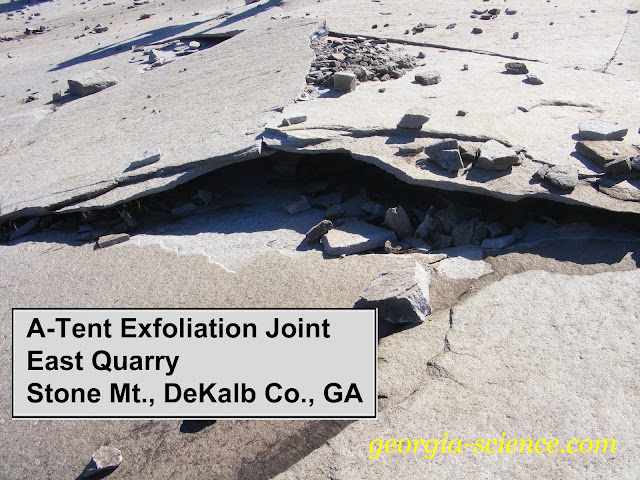Figure 1.
It appears that along with complex structural features in heavily-weathered metamorphics, this site, at Laurel Park at Lake Lanier in Hall County, Georgia, has a "Tortured Pegmatite" (right half of photo). The host rock was probably an amphibolite or maybe a biotite schist (my choice is the former) that has undergone extensive Ductile Deformation in addition to the Chemical Weathering. The Pegmatite itself seems to be primarily Quartz & K Feldspar, with minor Muscovite.
The park is located on a peninsula that extends roughly southeast into Lake Lanier and from the perspective of nearby Cleveland Highway (US Hwy 129/GA Hwy 11), the feature above is on the southwest side of the peninsula, near the distal end.
I was drawn to the park by way of a TV news report. Due to a protracted drought (in 2007) and Corps of Engineers' mistake, water levels were about 12 feet below the Full Pool elevation of 1071.00 feet above MSL.
On the other side of the peninsula, close to the tip, were exposed a portion of the concrete grandstands of an old, submerged raceway, locally known as Looper Speedway. As I am a fan of stock car racing, I went to get a few photos and wound up wandering the park shoreline for a couple of hours, looking at the geologic features.
Also known as Gainesville Speedway, it was a 1/2 mile dirt raceway that hosted stock and modified stock car races from 1949 until it closed during the filling of the lake in 1956. I think I heard Lee Petty's name mentioned as having raced there, as well as (probably) the Flock brothers (from Atlanta).
Returning to the lakeside features, Figure 2 is a broader view of the Wavecut Bench shoreline of the west side of the peninsula, with other exposures of "Tortured Pegmatite" amidst the heavily "saprolized" country rock discussed above. As with Figure 3, here the metamorphic saprolite is overlain by sands and rounded quartz pebbles, derived from the overlying eroded paleo river gravels (containing small amounts of heavy minerals and gold).
Figure 2.
Further northwestward along the west side of the peninsula were miniature Wave-Cut benches in the shoreline sands, temporarily recording the decline of lake water levels during the multi-year drought (2006 - 2009).
Figure 3.
Figure 4.
Some of these sands may have been introduced as "Beach Nourishment" for the nearby park.
Above the old concrete bleachers was this Nonconformity (Sedimentary over Metamorphic Saprolite).
Figure 5.
There are other interesting places along the shores of Lake Lanier that I have visited during Protracted and Winter Seasonal Droughts, including the west side of Van Pugh Park (where there are exposures of small-scale Ductile Deformation and a Tourmaline-K Feldspar Pegmatite), the subject of a future post.














